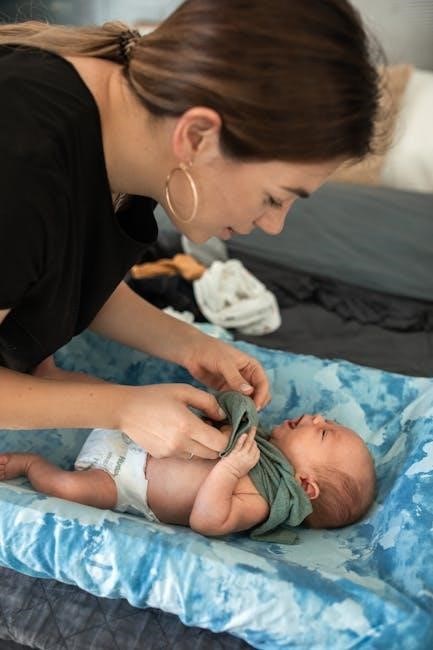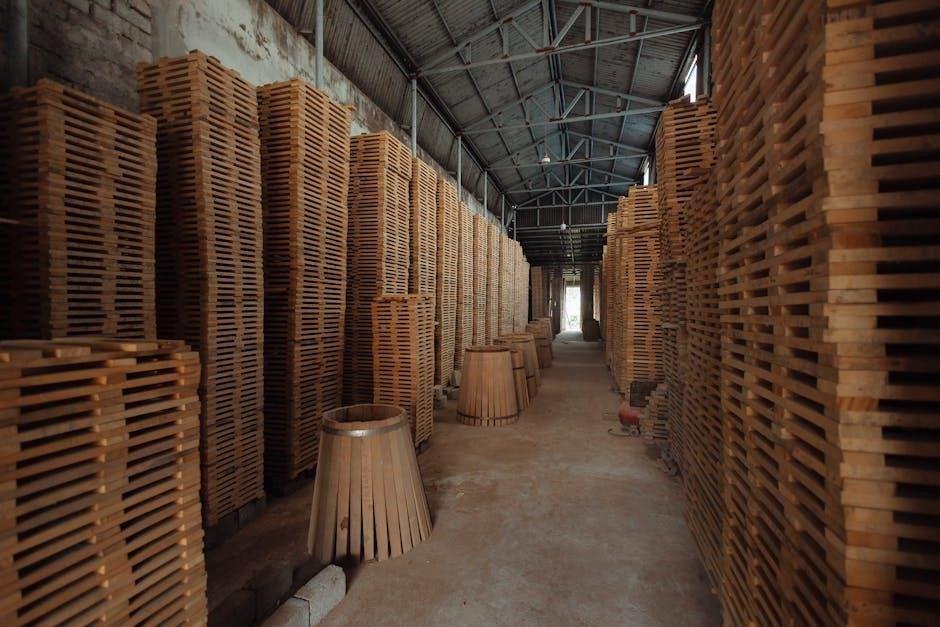Stockpiling diapers is a practical strategy for expectant parents, offering significant cost savings and convenience. By building a diaper stockpile, families ensure they are always prepared for their baby’s needs, avoiding last-minute purchases and potential shortages. This guide provides essential tips and insights to help you create an efficient and budget-friendly diaper stockpile, ensuring peace of mind as you welcome your new baby.

Why Building a Diaper Stockpile is Essential
Building a diaper stockpile is a smart and practical approach for new parents, offering financial savings and peace of mind. Diapers are a daily necessity, and stockpiling ensures you never run out unexpectedly. It also allows you to take advantage of bulk discounts and sales, reducing long-term costs. Additionally, having a stockpile prepares you for emergencies or supply shortages. By planning ahead, you avoid last-minute, costly purchases and ensure your baby’s needs are always met. A well-stocked supply provides convenience and reassurance, making parenthood easier and less stressful.
Benefits of Having a Diaper Stockpile
A diaper stockpile offers numerous benefits, including significant cost savings through bulk purchases and sales. It provides peace of mind, ensuring you’re never caught without diapers during late-night emergencies or supply shortages. Stockpiling also allows you to take advantage of discounts and coupons, reducing long-term expenses. Additionally, it offers flexibility, as you can try different brands or sizes without immediate pressure. Having a stockpile also supports environmental sustainability by reducing frequent trips to the store. Overall, it’s a practical and stress-reducing strategy for new parents, ensuring their baby’s needs are consistently met with ease and efficiency.

Understanding Diaper Usage and Sizes
Babies use 2,500–3,000 diapers annually, varying by size as they grow. Stockpiling requires understanding size progression to avoid waste and ensure adequate supply throughout infancy.
How Many Diapers a Baby Uses in the First Year
A baby typically uses 2,500 to 3,000 diapers in the first year, depending on their size and growth rate. Newborns require 300 diapers per month, while older babies use fewer as they grow. Stockpiling diapers by size ensures you’re prepared for each stage. Purchasing in bulk during sales can help reduce costs. Keep in mind that diaper usage decreases as babies grow, so it’s essential to plan accordingly to avoid waste. Storing diapers in a cool, dry place and using airtight containers will maintain their quality and extend their shelf life for future use.
Diaper Sizes and Growth Patterns
Babies grow quickly, and diaper sizes increase gradually to accommodate their development. Newborns typically start with size 1, while larger babies may begin with size 2. As infants grow, they transition through sizes 3, 4, 5, and eventually 6 for toddlers. Cloth diapers offer adjustable sizing, while disposable diapers have fixed sizes. Understanding growth patterns helps in stockpiling the right quantities for each stage. Most babies spend the most time in sizes 2, 3, and 4, with size 1 being the shortest phase. Plan your stockpile according to these growth milestones to ensure a steady supply for your baby’s needs.
How to Determine the Right Quantity for Each Size
To determine the right quantity for each diaper size, consider the average time spent in each size and daily diaper usage. Start with size 1 for newborns, needing around 100 diapers. Size 2 requires about 200, size 3 around 300, and size 4 approximately 400. Adjust based on growth rates and weight. Balance stockpiling to avoid excess and ensure enough supply. Use online guides or calculators for more accurate estimates, ensuring a well-stocked supply that meets the baby’s needs without waste or extra expense. This balanced approach helps in managing diaper stockpiling efficiently.

Choosing the Right Diapers and Brands
Selecting the right diapers and brands involves considering absorbency, comfort, and budget. Look for brands offering reliable quality, skin-friendly materials, and eco-friendly options. Always check reviews and compare features to ensure the best fit for your baby’s needs while staying within budget.
Disposable vs. Cloth Diapers: Pros and Cons
Disposable diapers offer unmatched convenience, with easy-to-use designs and no washing required, making them ideal for busy parents. They are hygienic and come in various sizes to fit growing babies. However, they can be costly over time and contribute to environmental waste. Cloth diapers, while requiring regular laundering, are eco-friendly and budget-friendly in the long run. They also reduce landfill contributions but demand more effort and initial investment in supplies. Ultimately, the choice depends on lifestyle, budget, and environmental priorities, as both options have trade-offs in terms of convenience, cost, and sustainability.
Popular Diaper Brands and Their Features
Popular diaper brands like Pampers, Huggies, and Luvs are known for their reliability and quality. Pampers offers exceptional fit and absorbency, while Huggies emphasizes a snug, comfortable design. Eco-friendly options like Seventh Generation cater to environmentally conscious parents. Store-brand diapers, such as those from Target or Walmart, provide affordable alternatives without compromising on performance. Each brand offers unique features, such as overnight protection, wetness indicators, or plant-based materials. When stockpiling, consider your baby’s specific needs and preferences to ensure the best fit and comfort.
Factors to Consider When Selecting a Brand
When choosing a diaper brand, consider factors like absorbency, comfort, and skin sensitivity. Some babies may require hypoallergenic options to prevent rashes. Brand loyalty often develops based on performance and fit. Budget is another key factor, as prices vary significantly between brands. Additionally, eco-conscious parents might prefer sustainable or biodegradable options. Reading reviews and comparing features can help narrow down choices. Ultimately, the best brand is one that meets your baby’s needs while fitting your lifestyle and budget. Prioritize quality and reliability to ensure your stockpile provides long-term satisfaction.

Where and How to Buy Diapers for Stockpiling
Purchase diapers in bulk from retailers like Amazon, Costco, or Target for significant savings. Use coupons, subscribe-and-save options, or gift cards to maximize discounts. Compare prices online and in-store to find the best deals. Consider buying during sales or using cashback apps. Always check return policies in case of size mismatches. Stock up when diapers are at their lowest price point to ensure your stockpile is cost-effective and convenient.
Best Places to Buy Diapers in Bulk
Amazon, Costco, and Target are top destinations for buying diapers in bulk, offering competitive pricing and convenient delivery options. Amazon’s subscribe-and-save feature provides discounts and regular shipments, while Costco and Target offer bulk packs at lower per-diaper costs. Warehouse clubs like Sam’s Club also offer bulk deals. Online marketplaces often have sales and coupons, making them ideal for stockpiling. Additionally, local pharmacies or supermarkets may carry bulk packs, so it’s worth checking multiple retailers to compare prices and find the best deals for your needs.
How to Find Deals, Discounts, and Coupons
Finding deals on diapers requires consistent effort but can yield significant savings. Start by shopping during sales or using manufacturer coupons, which are often available online or in weekly ads. Sign up for rewards programs like Amazon’s subscribe-and-save or Target’s RedCard for discounts. Apps like RetailMeNot or Honey can help you find promo codes. Additionally, follow diaper brands on social media for exclusive offers. Track price cycles to buy at the lowest points, and consider stockpiling during seasonal sales or holiday events. Always set a budget and stick to it to avoid overspending while building your stockpile.
Online Shopping vs. In-Store Purchases
Online shopping offers unparalleled convenience for stockpiling diapers, allowing you to compare prices, use coupons, and buy in bulk from the comfort of your home. Platforms like Amazon often provide discounts, free shipping, and subscribe-and-save options, making it easier to replenish your supply. In-store purchases, however, allow you to see products firsthand, take advantage of immediate deals, and avoid delivery wait times; For emergencies, in-store shopping is more practical. Ultimately, combining both methods ensures flexibility, enabling you to maximize savings and convenience based on your specific needs and preferences.

Timing Your Purchases for Maximum Savings
Timing your purchases is key to maximizing savings. Buy diapers in bulk during major sales and holidays when discounts are deepest. Set a budget and stick to it, ensuring you stockpile efficiently without overspending.
When to Start Stockpiling Diapers
Start stockpiling diapers as early as 12-20 weeks into your pregnancy to ensure you’re prepared for your baby’s arrival. This allows time to take advantage of sales and avoid last-minute rushes. Begin with smaller sizes (1 and 2) since newborns grow quickly. Consider your storage space and your baby’s potential size at birth. Purchasing a mix of sizes ensures flexibility. Don’t forget to check expiration dates and store diapers in a cool, dry place. Starting early also helps spread the cost over time, making it more manageable. This proactive approach ensures you’re ready for your baby’s needs from day one.
Seasonal Sales and Holiday Deals
Take advantage of seasonal sales and holiday deals to maximize your diaper stockpile savings. Major retailers often offer significant discounts during holidays like Black Friday, Cyber Monday, and end-of-year sales. Additionally, keep an eye out for baby-specific promotions and subscription services that offer bulk discounts. Timing your purchases during these periods ensures you get the best value. Use coupons, price-tracking apps, and cashback programs to further reduce costs. Always check expiration dates and store diapers properly to maintain quality. By strategically shopping during these events, you can build a substantial stockpile while staying within your budget.
Setting a Budget and Buy Price
Setting a budget and determining a buy price are crucial steps in stockpiling diapers efficiently. Allocate a specific amount for diaper purchases and stick to it to avoid overspending. Research the average price per diaper in your preferred brand and size to establish a target buy price. Use price-tracking tools or apps to monitor fluctuations and buy when prices drop below your set threshold. Consider bulk purchases at discounted rates, but ensure you stay within your budget. This approach ensures you maximize savings while maintaining control over your spending, making your diaper stockpile both cost-effective and sustainable.

Storing Your Diaper Stockpile
Store diapers in a cool, dry place to maintain quality. Use airtight containers or plastic bins to protect from moisture and pests. Avoid basements prone to flooding and keep them off the floor. Ensure the storage area is clean and well-ventilated to preserve the diapers’ condition. Proper organization helps in accessing sizes easily as your baby grows. This method ensures your stockpile remains usable and ready when needed, providing peace of mind for your baby’s care.
Best Practices for Storing Diapers
Store diapers in their original packaging to maintain freshness and prevent moisture absorption. Place them in a cool, dry area away from direct sunlight and humidity. Use airtight containers or plastic bins to protect from pests and dust. Avoid basements or attics prone to flooding or extreme temperatures. Keep diapers off the floor and organize them by size for easy access. Check expiration dates and ensure older stock is used first. Label containers for clarity and convenience. This method ensures your diaper stockpile remains in excellent condition and ready for use when needed.

Protecting Your Stockpile from Moisture and Pests
To safeguard your diaper stockpile, store it in airtight containers or plastic bins to shield from moisture and pests. Use silica gel packets or bay leaves to repel insects naturally. Ensure the storage area is dry, with a dehumidifier if necessary. Avoid damp spaces like basements without proper sealing. Regularly inspect for signs of moisture or pests, and keep the area clean. Elevate containers off the floor to prevent water damage. These steps ensure your diaper stockpile remains dry, pest-free, and ready for use when needed, avoiding costly waste and maintaining quality.

Organizing Your Diaper Supply
Organizing your diaper stockpile is crucial for easy access and efficient use. Use shelves or bins labeled by size to categorize diapers, ensuring you can quickly find what you need. Store larger quantities in the back and smaller ones upfront. Rotate stock regularly to use older items first, preventing expiration or waste. Keep wipes and accessories nearby for convenience. A well-organized system saves time, reduces clutter, and helps you track inventory, making diaper management simple and stress-free. This method ensures you always have a steady supply ready for your baby’s needs without unnecessary hassle or waste.

Additional Tips for a Successful Diaper Stockpile
Monitor expiration dates, rotate stock, and store diapers in dry, pest-free areas. Consider gift cards and flexible sizing to adapt to baby’s growth and preferences.
Stockpiling Wipes and Accessories
Stockpiling wipes and accessories is just as important as diapers. Aim to store at least 500-700 wipes per month for the first year. Consider buying wipes in bulk to save money and ensure availability. Additionally, stock up on diaper creams, ointments, and disposable bags for soiled diapers. Store these items in a cool, dry place, using airtight containers to protect from moisture and pests. Rotate your stock regularly to avoid expiration and ensure quality. This approach provides convenience and peace of mind, keeping you prepared for all your baby’s needs throughout the day and night.
Managing Expiration Dates and Quality
Properly managing expiration dates and quality is crucial for maintaining your diaper stockpile. Diapers typically don’t expire, but their quality can degrade over time if exposed to moisture or pests. Always check the packaging for damage or signs of wear before storing. Use the “first in, first out” rule to ensure older stock is used before newer supplies. Rotate your stock every 6-12 months to prevent degradation. Store diapers in a cool, dry place, away from direct sunlight, to preserve their integrity. Regularly inspect your stockpile for any issues and replace items as needed. This ensures your diapers remain effective and reliable for your baby’s needs.
Handling Returns and Exchanges
When managing returns and exchanges for your diaper stockpile, it’s essential to stay organized and informed. Start by reviewing the return policies of the stores where you purchased the diapers, as each retailer may have different requirements regarding receipts, time frames, and whether refunds or exchanges are offered. Ensure that diapers are in their original packaging and unopened to facilitate smoother returns. For online purchases, be aware of any specific procedures for mailing back items. Consider using gift cards for purchases, as they can provide flexibility for exchanges without the need for cash refunds. To avoid issues, rotate your stockpile to use older diapers first, preventing degradation in quality over time. Additionally, maintaining an organized system for receipts and purchase tracking can simplify the return process. If possible, consider donating unused diapers to those in need as a sustainable alternative to traditional returns, reducing potential waste and supporting your community.
Building a diaper stockpile is a smart and practical way to save money and stay prepared for your baby’s needs. With careful planning and organization, you can ensure convenience, reduce financial stress, and enjoy peace of mind. The effort to stockpile diapers is well worth it, as it provides long-term benefits for both your baby’s comfort and your family’s budget.
Key Takeaways for Building a Diaper Stockpile
- Start stockpiling during pregnancy to avoid last-minute stress.
- Buy in bulk when prices are low to maximize savings.
- Store diapers in a cool, dry place to maintain quality.
- Avoid overstocking larger sizes until your baby grows.
- Set a budget and stick to your “buy price” for diapers.
- Consider using gift cards or Amazon GCs for future purchases.
These strategies ensure you’re prepared and save money while avoiding common pitfalls.
Common Mistakes to Avoid
Overstocking larger sizes too early is a frequent error, as babies grow quickly and may outsize diapers before use. Buying too many of a single brand without testing can lead to waste if the fit isn’t right. Ignoring expiration dates or storing diapers improperly in damp areas can compromise quality. Additionally, not setting a budget can lead to overspending, while failing to track sales may mean missing out on the best deals. Avoid these pitfalls to ensure your stockpile is both practical and cost-effective.
Success Stories and Real-Life Examples
Many parents have successfully saved money and reduced stress by stockpiling diapers. One mom shared how she saved over $500 by buying diapers in bulk during sales and using coupons. Another family avoided last-minute trips to the store by maintaining a well-organized stockpile. A first-time dad highlighted how having a stockpile gave him peace of mind during his baby’s first year. These stories demonstrate how a well-planned diaper stockpile can make a significant difference in managing the costs and challenges of parenthood. Real-life examples prove that stockpiling is a practical and effective strategy for many families.



